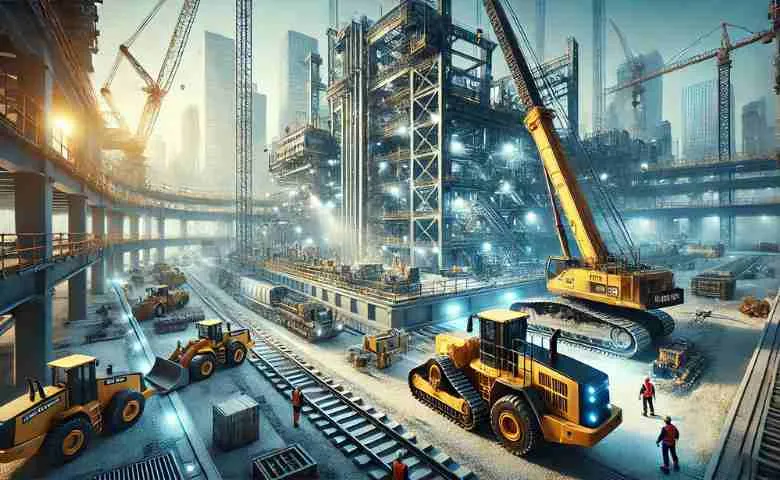Last Updated on October 16, 2024 by Admin
Understanding Heavy Machinery in Construction
In today’s fast-paced construction industry, heavy machinery is pivotal in enhancing efficiency and productivity. According to industry reports, heavy machinery accounts for up to 40% of construction project costs but significantly enhances operational efficiency. This reliance on machinery has transformed projects’ execution, making them faster and more cost-effective. Skid steers, mini excavators, and bulldozers are vital to this evolution, driving project success in modern construction.
Overview of Heavy Machinery
Heavy machinery refers to large, powerful equipment designed for substantial construction tasks, including excavation, grading, and material handling. Common types of heavy machinery include skid steers, mini excavators, and bulldozers. Over the years, these machines have evolved remarkably, incorporating advanced technologies that improve their capabilities, efficiency, and safety features. This evolution has made them indispensable in contemporary construction practices.
Three Heavy Machinery Key Roles
Skid Steers
Skid steers are compact machines equipped with a variety of attachments for diverse tasks. They excel in digging, grading, and material handling, especially in tight spaces where larger machinery cannot operate effectively. Their maneuverability allows them to navigate small job sites quickly, facilitating efficient operations that significantly reduce project timelines.
Mini Excavators
Mini excavators are renowned for their versatility, making them ideal for urban projects and confined spaces. They provide exceptional digging power and can easily handle tasks such as trenching and grading. Their compact size allows for rapid maneuvering, enabling precise digging and minimal disruption to surrounding areas. This efficiency translates into faster project completion times, a critical factor in today’s competitive construction environment.
Practice 15+ AI-generated technical and HR interview questions for Civil, BIM, QS, Planning, HSE and Construction roles. Get instant feedback, improved answers, a 7-day improvement plan, and a full PDF report. Designed exclusively for construction professionals.
One free full interview session included. No credit card required.
Bulldozers
Bulldozers are powerful machines essential for site preparation, earthmoving, and debris clearing. Their robust capabilities enable them to move large volumes of earth swiftly, which is vital in the early stages of a construction project. By enhancing productivity and reducing the time needed for site preparation, bulldozers play a crucial role in keeping projects on schedule.
Challenges and Considerations
Despite the advantages, there are challenges associated with heavy machinery. The initial costs of purchasing or renting equipment can be significant, requiring careful financial planning. Additionally, proper training is essential to ensure that operators can use the machinery safely and effectively. Investing in training programs not only enhances safety but also maximizes the machinery’s efficiency.
Regular maintenance is a critical aspect of operating heavy machinery. Scheduled servicing helps prevent costly repairs and minimizes downtime, ensuring that equipment remains in optimal condition. Maintaining these machines with high-quality replacement rubber tracks is essential for maximizing efficiency and performance. Utilizing aftermarket rubber tracks and undercarriage parts can also help reduce costs without compromising quality. Therefore, construction companies must prioritize maintenance to protect their investments and ensure that project timelines are met.
Impact on Project Efficiency
The integration of heavy machinery into construction projects has led to significant labor cost reductions. By minimizing the need for a large workforce, companies can save on labor expenses while still meeting project demands. For instance, a construction project that traditionally required a dozen workers for manual excavation can often be completed with just a few operators managing heavy machinery.
Moreover, the time savings associated with heavy machinery are substantial. Projects that once took months can now be completed in weeks, thanks to the efficiency of machines like skid steers and mini excavators. Case studies reveal that a recent urban development project reduced its timeline by 30% after incorporating mini excavators for trenching, allowing for a faster return on investment.
Looking Ahead: The Future of Construction with Heavy Machinery
Heavy machinery plays a crucial role in enhancing efficiency in modern construction, driving down costs, and expediting project timelines. As technology continues to evolve, the capabilities of machines like skid steers, mini excavators, and bulldozers will expand, offering even greater benefits to the industry. Construction professionals should embrace these advancements and strategically integrate heavy machinery into their projects to achieve optimal outcomes. The future of construction is undeniably linked to the effective use of heavy machinery, and those who adapt will lead the way in this dynamic industry.
Related Posts:
- Mining Mysteries: What Construction Companies Use For Excavating
- Compact Excavators for Rent: Everything You Need to Know
- Different Types of Mini Piling and the Benefits It Can Provide
- How to Become a Heavy Construction Equipment Operator


